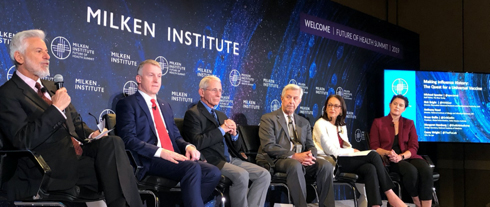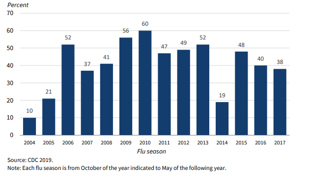In Pursuit of Next-Generation Influenza Vaccines
Our 2019 Year in Review, looking back at our work, and that of our partners, to propel development of a universal influenza vaccine.

As 2020 begins and the inevitable annual influenza season takes hold in the Northern Hemisphere, we are reminded once again of the critical need to drive innovation toward next-generation influenza vaccines. For our first Medium post, The Sabin Vaccine Institute’s Influenzer Initiative is excited to share a look back at our work, and that of our partners, to propel development of a universal influenza vaccine.
Accelerating the Development of a Universal Influenza Vaccine: The report of the Sabin-Aspen Vaccine Science and Policy Group

In late 2018, the Sabin-Aspen Vaccine Science and Policy Group came together to examine critical issues facing the vaccine innovation ecosystem. Compelled by the 100-year commemoration of the 1918 pandemic, the Group examined current opportunities and challenges facing the long-sought goal of a universal influenza vaccine. Their urgent call to action and the recommendations published in this report provide the foundational springboard for Sabin’s activities throughout 2019. Sabin’s Influenzer Initiative efforts, in collaboration with Flu Lab, have focused on propagating this work—and the report’s “Big Ideas,”—throughout the influenza ecosystem. To date, we have engaged more than 150 leaders representing academic research, p
ublic and private research funding organizations, the biotech and pharmaceutical industries, and public policy institutions. Each of these individuals can play a vital role in advancing, aligning, and further interrogating the priorities and approaches proposed in the report.
Senate briefing- Meet the Experts of Influenza Vaccine Research
 Responding to the Sabin-Aspen Group’s call for action, Sabin, along with the Foundation for Vaccine Research and the It’s Time Campaign, supported the participation of influenza vaccine research experts in a Senate briefing at the Dirksen Senate Office Building on March 5. Chaired by David Baltimore and Simon Wain-Hobson, the briefing featured presentations by Anthony Fauci, Florian Krammer, Ian Wilson, Scott Hensley, Jesse Bloom, Gary Nabel, Kathrin Jansen and Russell Basser to an audience that included Senator Edward Markey (D-MA) and Rosa DeLauro (D-CT), sponsors of the Flu Vaccine Act. This Act authorizes $200 million per year, over five years, for NIH to pursue basic science research necessary
Responding to the Sabin-Aspen Group’s call for action, Sabin, along with the Foundation for Vaccine Research and the It’s Time Campaign, supported the participation of influenza vaccine research experts in a Senate briefing at the Dirksen Senate Office Building on March 5. Chaired by David Baltimore and Simon Wain-Hobson, the briefing featured presentations by Anthony Fauci, Florian Krammer, Ian Wilson, Scott Hensley, Jesse Bloom, Gary Nabel, Kathrin Jansen and Russell Basser to an audience that included Senator Edward Markey (D-MA) and Rosa DeLauro (D-CT), sponsors of the Flu Vaccine Act. This Act authorizes $200 million per year, over five years, for NIH to pursue basic science research necessary
Answering a Call to Action
 To continue brainstorming with solutions-driven experts and decision makers, the Influenzer Initiative, hosted by the Wellcome Trust in London, engaged in A Call to Action: Driving Innovation towards the Development of Universal Influenza Vaccine on April 3-4, 2019. This wasn’t just another meeting—it was a chance to invent new ways to drive innovation in influenza vaccine research and development.
To continue brainstorming with solutions-driven experts and decision makers, the Influenzer Initiative, hosted by the Wellcome Trust in London, engaged in A Call to Action: Driving Innovation towards the Development of Universal Influenza Vaccine on April 3-4, 2019. This wasn’t just another meeting—it was a chance to invent new ways to drive innovation in influenza vaccine research and development.
In addition to outstanding influenza and vaccine researchers, participants included champions of science and technology across a range of disciplines, leaders of industry, visionary investors, and thought leaders in policy. We asked this diverse and talented group to brainstorm key areas of opportunity to engage the broad assets of science and technology to drive novel problem-solving aimed at breakthroughs in UIV development. Ideas for promoting the action needed converged around these themes:
- Bringing new minds to the challenge
- Sharing knowledge dynamically
- Enabling risk taking
- Building protected convergent spaces
- Giving the gift of focus to influenza researchers
Options X for the Control of Influenza: Singapore

The 10th edition of Options for the Control of Influenza (Options X) conference, which took place August 28-September 1, presented a timely opportunity to spread, discuss, and pressure-test recommendations from the Sabin-Aspen report at the largest scientific conference devoted to influenza. Sabin and Flu Lab hosted a dialogue among representatives of biotech, industry, government, universities, and philanthropy to explore how the report’s concluding “Big Ideas” could be incentivized and realized. Specifically, we asked participants to probe the following objectives drawn from the Sabin-Aspen report:
Enabling collaboration among inter- and intra-disciplinary collaboration among scientists and vaccinologists, experts who are traditional and non-traditional to UIV, researchers and product developers, and UIV policy and programmatic stakeholders.
Key takeaways:
- more small group, interdisciplinary, and cross-institution discussions would be welcomed
- collaboration must be incentivized and explicitly supported, including through structural innovation
Product-focused support: Enable the progression of vaccine candidates or platforms to create a UIV that achieves global access and broad program implementation. Identify, address, and overcome challenges inherent in licensing a UIV, recognizing the rewards that success will bring.
Key observation: it’s a long road, but there’s a market at the end.
Data- and asset-sharing: Provide shared resources, both as incentives for collaboration and to decrease barriers to entry for any single player or new players.\
Key needs:
- A platform for real discussion between academia and industry
- A new system of incentives to support timely sharing of all research results—including those that are negative, null, dogma-breaking, and confirmatory
- Detailed descriptions of pre-clinical candidate progress, including experimental results leading to “failures”
Catalytic funding: Allocate funding as an incentive for novel collaboration and research, to enable data and asset-sharing, and to drive product-focused support; ensure that funding is flexible, rapidly deployed, and appropriately targeted to drive catalytic impact.
Key response:
Funding and funding structures must incentivize industry to innovate and sell novel products.
Championing the cause: A single-mission entity, vested with authority and significant funding, must lead the global UIV initiative.
Key objectives:
- an evolved approach to UIV research and development that brings fresh focus, creativity, and urgency
- long-term resources for a sustained, robust effort
With new grants, Gates foundation takes an early step toward a universal flu vaccine

Also at Options X, the Bill & Melinda Gates Foundation announced their Global Grand Challenges grantees for Ending the Pandemic Threat: A Grand Challenge for Universal Influenza Vaccine Development. The Influenzer Initiative connected with the following teams, whose proposals promise progress toward broadly protective and universal influenza vaccines, among other transformative technologies:
- Jonathan Heeney, Rebecca Kinsley, the Laboratory of Viral Zoonotics, University of Cambridge, who will use an existing DNA vaccine approach for influenza.
- Yoshihiro Kawaoka, Dept. of Pathobiological Sciences, University of Wisconsin-Madison and University of Tokyo, who will use a cocktail of synthetic proteins designed to focus the immune system’s response to vaccine on parts of flu viruses that are common to all flu viruses.
- Patrick Wilson, Dept. of Medicine, University of Chicago; Sarah Cobey, Dept. of Ecology and Evolution, University of Chicago; Jesse Bloom, Fred Hutch Cancer Center; and Florian Krammer, Dept. of Microbiology at Icahn School of Medicine at Mount Sinai; and Ian Wilson and Andrew Ward from the Scripps Research Institute who will mine a library of human antibodies to influenza to design a new protein sequence for a novel, potent vaccine that should provoke a broader antibody response.
- Peter Kwong and Gwo-Yu Chuang of the Vaccine Research Center at the National Institute of Allergy and Infectious Diseases, who will apply lessons from HIV research to identify sites of vulnerability suitable to the development of a universal vaccine.
Interviews conducted by the Sabin Influenzer Initiative with these researchers and other influenza innovators at Options X, highlighted the value of interdisciplinary collaboration and scientific convergence for UIV development. Look for excerpts from these interviews in our February 2020 release of the Influenza Innovators video on the Influenzer website.
Milken Future of Health Summit

A key opportunity to reinforce the report’s messages occurred in October, at the Milken Institute’s Future of Health Summit, which featured the panel discussion, “The Quest for a Universal Influenza Vaccine.” Participants included Sabin’s Bruce Gellin (president of Global Immunization), Sabin-Aspen Group members Margaret Hamburg (foreign secretary of the National Academy of Medicine) and Michael Specter (staff writer at The New Yorker and panel moderator), along with Rick Bright, of the US Department of Health and Human Services; Anthony Fauci, Director of the National Institute of Allergy and Infectious Diseases, NIH; and Casey Wright, CEO of Flu Lab.
Council’s Influenza Report Spurs Broad Response

The White House Council of Economic Advisers released a sobering report predicting devastating health and economic losses in the United States associated with influenza pandemics. In response, the President issued an Executive Order on Modernizing Influenza Vaccines in the United States to Promote National Security and Public Health. The Order reflects the imminent threat of pandemic influenza, the inadequacy of current manufacturing methods to meet pandemic demand, the poor uptake of seasonal influenza vaccine, and the variable and marginal effectiveness of seasonal vaccine.
The Order notes that most influenza vaccines are made in chicken eggs, “a 70-year-old process that requires months-long production timelines, limiting their utility for pandemic control; rely on a potentially vulnerable supply chain of eggs; require the use of vaccine viruses adapted for growth in eggs, which could introduce mutations of the influenza vaccine virus that may render the final product less effective; and are unsuitable for efficient and scalable continuous manufacturing platforms.” In addition to promoting actions to modernize the production of influenza vaccines, the Order charges the Department of Health and Human Services with coordinating US government agencies’ efforts toward innovation in influenza vaccine development, in the spirit of the second Sabin-Aspen “Big Idea.”
In December, commentary published in Fortune from Dr. Harvey Fineberg and Dr. Shirley Tilghman, Co-Chairs of the Sabin-Aspen Vaccine Science and Policy Group, responded to and amplified the findings of the CEA report. Fineberg and Tilghman call on new public and private sector partners to collaborate on, and to invest in, efforts to accelerate and augment current funding and research to drive breakthroughs for a UIV.
Looking Ahead: The Convergence Science Agenda

Responding to the calls from the experts and thought leaders we’ve engaged to-date and building from the Sabin-Aspen Vaccine Science & Policy Group report, Sabin will further efforts in 2020 to develop an innovation agenda, shaped by collaborative convergence, that is aimed at accelerating the development of next-generation, universal influenza vaccines (UIV). This Convergence Science Agenda for UIV will integrate the knowledge of influenza and vaccine development experts with the methods and tools of a diverse set of emerging science and technology experts. This Agenda will detail novel pathways and approaches for generating new solutions to long-standing challenges in UIV development: to expand the breadth and durability of vaccine protection; to reduce production timelines; to accelerate testing and clinical trials of products to replace existing vaccines.
In developing, promoting, and disseminating a Convergence Science Agenda for UIV, Sabin seeks to stimulate, inspire, and provide foundational guideposts for investing the knowledge, technical, and financial resources required to realize the transformative goal of next-generation, universal influenza vaccines.
